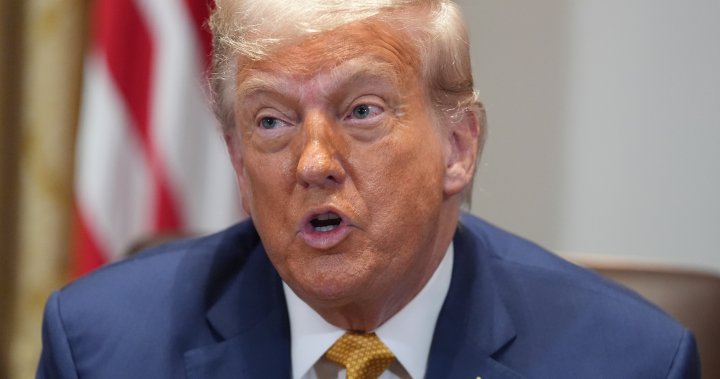The United States plans to impose a 50 per cent tariff on all copper imported into the country, U.S. President Donald Trump said on Tuesday.
He also said the plan is to impose a 200 per cent tariff on pharmaceuticals.
“I believe, the tariff on copper we’re going to make it 50 per cent,” Trump told reporters at the White House on Tuesday.
The Trump administration had announced a so-called Section 232 investigation into U.S. imports of the metal, which is a key component in supply chains for electronics and clean energy, in February.
On Tuesday, Trump also said he was planning new tariffs on pharmaceuticals.
“If they have to bring the pharmaceuticals into the country … they’re going to be tariffed at a very, very high rate, like 200 per cent. We’ll give them a certain period of time to get their act together,” he said.
“We’re going to be announcing pharmaceuticals, chips and various couple of other things — you know, big ones,” Trump told reporters.
While the U.S. in 2024 mined an estimated 1.1 million tonnes of copper and exported about a third of that in primarily unrefined form, it imported 810,000 tonnes , nearly all of it refined, according to the U.S. Geological Survey.

Get breaking National news
For news impacting Canada and around the world, sign up for breaking news alerts delivered directly to you when they happen.
Two-thirds of U.S. imports of refined copper comes from Chile, which is the world’s leading copper producer, with lesser amounts from Canada, Mexico and Peru.
Trump’s executive order accurately refers to China as the world’s leading refiner of copper, with over half the world’s smelting capacity.
Copper is a critical mineral, and along with metals like lithium and cobalt is used in things like rechargeable batteries and rare-earth elements for cellphones, LED lights and flat-screen TVs. Copper goes into the cords and transmission lines that plug gadgetry into power.
Canada is home to one per cent of the world’s total copper reserves, according to Natural Resources Canada.
In 2023, Canadian mines produced 508,250 tonnes of copper in concentrate, with nearly half originating from British Columbia. According to Natural Resources Canada, the country’s exports of copper and copper-based products were valued at $9.4 billion in 2023.
The United States is by far the largest destination for Canadian copper, importing 52 per cent of Canada’s total copper exports. This was followed by China at 17 per cent and Japan at 12 per cent.
Individual American states have sought to source cheaper drugs from Canada for decades.
In 2024, Florida became the first state to get a drug importation program approved by the U.S. Food and Drug Administration (FDA) under federal law.
More than a year later, however, the program has yet to begin, and no drugs have been imported to Florida from Canada.
Under federal requirements, state officials must first test the drugs to make sure they’re authentic and relabel them so that they comply with U.S. standards.
Trump in April signed an executive order on lowering drug costs that among other things, sought to “streamline and improve” within 90 days the program allowing states to import drug from Canada.
Colorado has said it expects its own Canadian drug import program to be approved by the FDA soon, and other states have submitted applications as well.
Health Canada says it has been “taking all necessary action to safeguard the drug supply and ensure Canadians have access to the prescription drugs they need” ever since the Florida program was approved.
–with files from Global’s Sean Boynton, Reuters and Associated Press
Read the full article here

